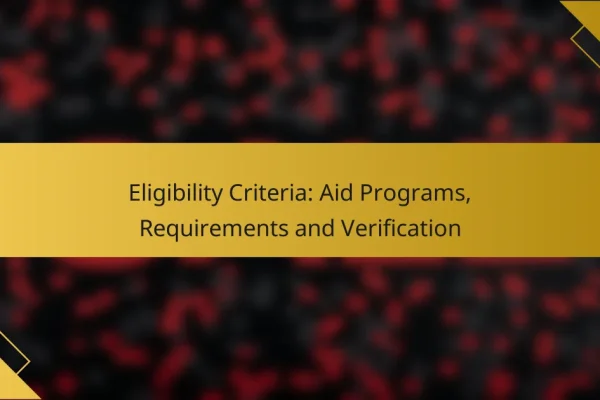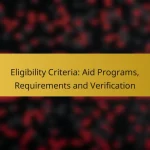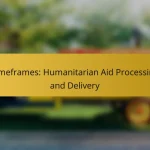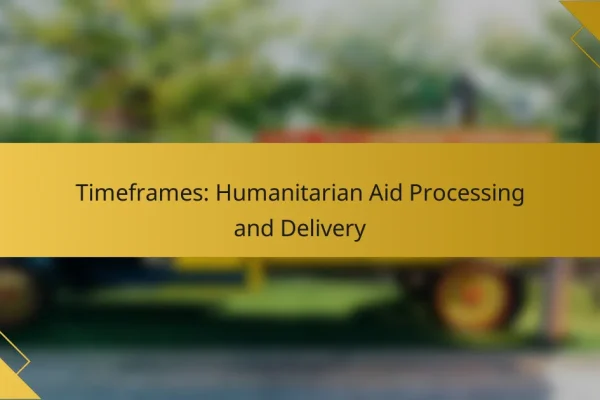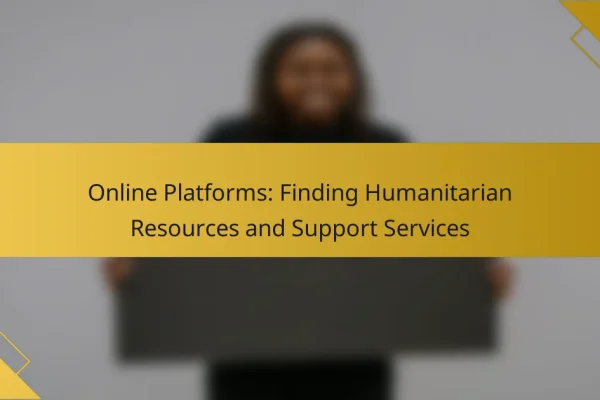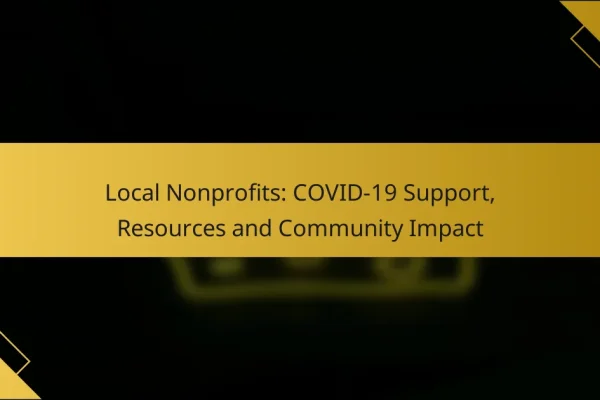How can individuals access humanitarian aid in the United States?
Individuals in the United States can access humanitarian aid through various government assistance programs, nonprofit organizations, and community resources. Each option offers different types of support, so understanding these avenues is essential for those in need.
Government assistance programs
The U.S. government provides several assistance programs designed to help individuals facing hardships. Programs like the Supplemental Nutrition Assistance Program (SNAP) and Temporary Assistance for Needy Families (TANF) offer financial support and food assistance to eligible families.
To access these programs, individuals typically need to apply through their state’s social services department. Eligibility often depends on income level, household size, and specific needs, so it’s important to gather necessary documentation before applying.
Nonprofit organizations
Numerous nonprofit organizations across the United States offer humanitarian aid, including food banks, shelters, and healthcare services. Organizations like the American Red Cross and local food pantries provide essential resources to those in crisis.
Individuals can find assistance by searching online for local nonprofits or by contacting national organizations that can direct them to nearby resources. Many nonprofits also offer programs tailored to specific populations, such as veterans or the homeless.
Community resources
Community resources play a vital role in providing humanitarian aid at the local level. Many communities have outreach programs, churches, and civic groups that offer food, clothing, and shelter to those in need.
To make the most of these resources, individuals should reach out to local community centers or check bulletin boards for information on available services. Networking with neighbors and community leaders can also uncover additional support options that may not be widely advertised.
What are the eligibility criteria for humanitarian aid?
Eligibility for humanitarian aid typically depends on several factors, including income level, residency status, and specific needs assessments. These criteria ensure that assistance reaches those who are most in need.
Income level requirements
Income level requirements often determine whether individuals or families qualify for humanitarian aid. Many programs prioritize low-income households, typically defined as those earning below a certain percentage of the national median income.
For example, in the United States, households earning below 200% of the federal poverty line may be eligible for various forms of assistance. It’s crucial to check local guidelines, as these thresholds can vary significantly by region.
Residency status
Residency status is another critical factor in determining eligibility for humanitarian aid. Many programs require applicants to be legal residents or citizens of the country where they seek assistance.
In some cases, refugees and asylum seekers may also qualify, but this can depend on specific regulations. Always verify the residency requirements of the aid program you are considering, as they can differ widely.
Specific needs assessment
A specific needs assessment evaluates the unique circumstances of applicants to determine their eligibility for humanitarian aid. This assessment often considers factors such as health conditions, disabilities, and family size.
Organizations may use standardized forms or interviews to gather this information. Being prepared to provide detailed information about your situation can help streamline the application process and improve your chances of receiving assistance.
What types of humanitarian aid are available?
Humanitarian aid encompasses various forms of assistance aimed at alleviating human suffering during crises. Key types include food assistance, medical aid, and shelter support, each designed to meet essential needs in emergency situations.
Food assistance programs
Food assistance programs provide essential nutrition to individuals and families affected by crises, including natural disasters and conflicts. These programs often include direct food distribution, cash transfers for purchasing food, and nutrition education.
Organizations like the World Food Programme (WFP) and local NGOs typically implement these initiatives. Recipients may receive food parcels, vouchers, or cash, depending on the program’s structure and local conditions.
Medical aid services
Medical aid services deliver critical healthcare to those impacted by emergencies, including access to medical supplies, vaccinations, and treatment for injuries or illnesses. These services often operate through mobile clinics or temporary healthcare facilities in affected areas.
International organizations, such as Médecins Sans Frontières (Doctors Without Borders), play a vital role in providing these services. It’s important for recipients to understand the types of medical care available and how to access them, as well as any necessary documentation.
Shelter and housing support
Shelter and housing support aims to provide safe living conditions for displaced individuals and families. This assistance can include temporary shelters, financial aid for housing, or reconstruction of homes damaged in disasters.
Agencies like UNHCR (United Nations High Commissioner for Refugees) often coordinate these efforts. It’s crucial for those in need to seek information on available shelters and any eligibility criteria for housing assistance, as these can vary significantly by region and situation.
How to apply for humanitarian aid?
To apply for humanitarian aid, individuals typically need to follow specific procedures set by the aid organization or government agency involved. These processes can vary significantly depending on the type of aid required and the applicant’s location.
Online application processes
Many organizations offer online application systems that streamline the process. Applicants usually need to visit the official website of the aid provider, create an account, and fill out the necessary forms. Be prepared to provide personal information and details about your situation.
Ensure that you have access to a reliable internet connection, as technical issues can delay your application. Some platforms may also require you to submit supporting documents electronically, so check the requirements beforehand.
In-person application steps
For those who prefer or need to apply in person, locate the nearest office of the humanitarian organization. It’s advisable to call ahead to confirm office hours and any specific requirements for in-person visits. Bring all necessary documents to facilitate the process.
During your visit, you may need to fill out forms on-site and provide additional information about your circumstances. Be prepared for possible wait times and ensure you have all required documentation to avoid multiple trips.
Documentation needed
Documentation requirements can vary, but common items include identification (such as a passport or national ID), proof of residence, and any relevant medical or financial records. Some organizations may also request letters of referral from local authorities or community leaders.
Before applying, check the specific documentation requirements of the aid provider to ensure you have everything ready. Missing documents can lead to delays or denial of your application, so it’s best to double-check your paperwork. Consider making copies of all submitted documents for your records.
What are the challenges in accessing humanitarian aid?
Accessing humanitarian aid often involves several significant challenges that can hinder effective support. Key obstacles include a lack of awareness about available resources, bureaucratic hurdles, and language barriers that complicate communication and understanding.
Awareness of available resources
Many individuals in need of humanitarian aid are unaware of the resources available to them. This lack of awareness can stem from insufficient outreach efforts by aid organizations or the complexity of aid programs.
To improve awareness, organizations can utilize local media, community leaders, and social networks to disseminate information. Engaging with community members can help ensure that information reaches those who need it most.
Bureaucratic hurdles
Bureaucratic hurdles often slow down the process of accessing humanitarian aid. These can include lengthy application processes, complicated eligibility criteria, and extensive documentation requirements.
To navigate these challenges, individuals should familiarize themselves with the specific requirements of aid programs. Keeping organized records and seeking assistance from local NGOs can help streamline the process and reduce delays.
Language barriers
Language barriers can significantly impede access to humanitarian aid, especially in regions with diverse linguistic communities. Miscommunication can lead to misunderstandings about the aid available or the application process.
To overcome language barriers, aid organizations should provide multilingual resources and employ interpreters when necessary. Community workshops that include language support can also facilitate better understanding and access to aid services.
How can technology improve access to humanitarian aid?
Technology enhances access to humanitarian aid by streamlining communication, improving resource distribution, and facilitating real-time information sharing. By leveraging mobile applications and online platforms, organizations can connect with affected populations more effectively and efficiently.
Mobile apps for aid distribution
Mobile applications play a crucial role in the distribution of humanitarian aid by enabling organizations to deliver assistance directly to those in need. These apps can track inventory, manage logistics, and provide real-time updates on aid availability, ensuring that resources reach the right people promptly.
For example, apps like “AidMatrix” and “GiveDirectly” allow users to receive financial aid directly to their mobile wallets, bypassing traditional banking systems. This method is particularly effective in regions with limited banking infrastructure, allowing for quicker and more reliable support.
Online platforms for information sharing
Online platforms facilitate the sharing of vital information among humanitarian organizations, governments, and affected communities. These platforms can include websites, social media channels, and dedicated forums where users can access updates on aid efforts, safety information, and available resources.
For instance, platforms like “ReliefWeb” and “HumanitarianResponse.info” provide centralized information on ongoing crises, helping organizations coordinate their efforts and avoid duplication. Utilizing these resources can significantly enhance the effectiveness of humanitarian responses and ensure that aid reaches those who need it most.
What role do local organizations play in humanitarian aid?
Local organizations are crucial in humanitarian aid as they provide immediate support and culturally relevant assistance to affected communities. They often have established trust and understanding of local needs, which enhances the effectiveness of aid delivery.
Understanding local needs
Local organizations are adept at identifying the specific needs of their communities, which can vary significantly from one region to another. They conduct assessments to determine what resources are most urgently required, whether it be food, medical supplies, or shelter. This localized knowledge ensures that aid is not only timely but also relevant.
Building trust and relationships
Trust is a vital component in humanitarian efforts, and local organizations often have longstanding relationships with community members. This trust facilitates smoother communication and cooperation during crises. When communities feel secure with the organizations providing aid, they are more likely to engage and participate in relief efforts.
Coordination with international agencies
Local organizations frequently act as intermediaries between international agencies and the communities they serve. They help ensure that aid is distributed effectively and that the initiatives align with local customs and regulations. This coordination can improve the overall impact of humanitarian efforts and reduce duplication of services.
Capacity building and sustainability
In addition to immediate relief, local organizations focus on capacity building, empowering communities to respond to future crises. They provide training and resources that enhance local skills and resilience. This approach fosters long-term sustainability, allowing communities to better handle emergencies independently.
